External links
| Novels |
|
|---|---|
| Short story collections |
|
| Short stories |
|
| Screenplays |
|
| Children's books |
|
| Related | |
| | This article about a short story (or stories) published in the 1930s is a stub. You can help Wikipedia by expanding it. |
"Red Leaves" is a short story by American author William Faulkner. First published in the Saturday Evening Post on October 25, 1930, [1] it was one of Faulkner's first stories to appear in a national magazine. [2] The next year the story was included in These 13 , Faulkner's first collection of short stories. [3]
"Red Leaves" has been described as "a vision of the inexorable, brutal pattern of nature that decrees that every living thing must die". [2] The title of the story symbolizes the American Indian, [4] specifically the Chickasaw: [5]
The red leaves referred to the Indians. It was the deciduation of nature that had suffocated, smothered, destroyed the Negro. The red leaves had nothing against him when they suffocated him and destroyed him.
— William Faulkner
With the death of Chief Issetibbeha, custom demands that all the Chickasaw leader's prized possessions be buried alive in the earth along with him. This includes his black servant, a slave who has served the chief since boyhood. The unnamed slave makes a desperate bid for freedom, taking refuge in the swamps and reflecting on his past life. Meanwhile, the dead chief's son Moketubbe, who is grossly overweight and has no real interest in leadership, is forced to marshal his forces and begin a manhunt for the fugitive slave. The few Indians willing to accompany Moketubbe are equally corrupt, decadent, and full of despair. As they slowly close in on the missing slave, they too reflect on the past, discussing the ways in which slavery and the coming of the white man have doomed them to crime, violence, and slow extinction as a people.
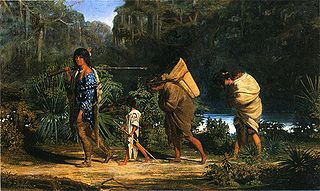
The Choctaw are a Native American people originally based in the Southeastern Woodlands, in what is now Alabama and Mississippi. Their Choctaw language is a Western Muskogean language. Today, Choctaw people are enrolled in three federally recognized tribes: the Choctaw Nation of Oklahoma, Mississippi Band of Choctaw Indians, and Jena Band of Choctaw Indians in Louisiana.

William Cuthbert Faulkner was an American writer known for his novels and short stories set in the fictional Yoknapatawpha County, based on Lafayette County, Mississippi, where Faulkner spent most of his life. A Nobel Prize laureate, Faulkner is one of the most celebrated writers of American literature and is widely considered the greatest writer of Southern literature.
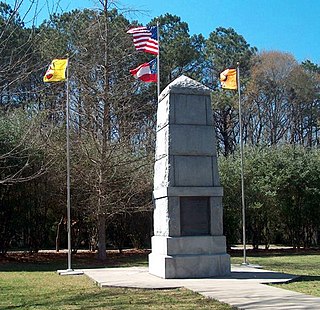
The Trail of Tears was a series of forced displacements of approximately 60,000 Native Americans of the Five Civilized Tribes between 1830 and 1850 by the United States government. Part of the Indian removal, this ethnic cleansing event was gradual, occurring over a period of nearly two decades. Members of the so-called Five Civilized Tribes—the Cherokee, Muscogee (Creek), Seminole, Chickasaw, and Choctaw nations —were forcibly removed from their ancestral homelands in the Southeastern United States to areas to the west of the Mississippi River that had been designated Indian Territory. The forced relocations were carried out by government authorities after the passage of the Indian Removal Act in 1830. The Cherokee removal in 1838 was brought on by the discovery of gold near Dahlonega, Georgia, in 1828, resulting in the Georgia Gold Rush.

The Chickasaw are an indigenous people of the Southeastern Woodlands. Their traditional territory was in the Southeastern United States of Mississippi, Alabama, and Tennessee. Their language is classified as a member of the Muskogean language family. In the present day, they are organized as the federally recognized Chickasaw Nation.
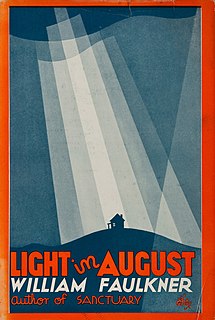
Light in August is a 1932 novel by the Southern American author William Faulkner. It belongs to the Southern gothic and modernist literary genres.

The term Five Civilized Tribes was applied by European Americans in the colonial and early federal period in the history of the United States to the five major Native American nations in the Southeast—the Cherokee, Chickasaw, Choctaw, Creek (Muscogee), and Seminole. Americans of European descent classified them as "civilized" because they had adopted attributes of the Anglo-American culture. Examples of such colonial attributes adopted by these five tribes, included Christianity, centralized governments, literacy in English, market participation, written constitutions, intermarriage with white Americans, and chattel slavery practices, including purchase of enslaved African Americans. For a period, the Five Civilized Tribes tended to maintain stable political relations with the European Americans, before the United States promoted Indian Removal of these tribes from the Southeast.

Sanctuary is a 1931 novel by American author William Faulkner about the rape and abduction of an upper-class Mississippi college girl, Temple Drake, during the Prohibition era. The novel was Faulkner's commercial and critical breakthrough and established his literary reputation, but was controversial given its themes. It is said Faulkner claimed it was a "potboiler", written purely for profit, but this has been debated by scholars and Faulkner's own friends.
Ikkemotubbe is a fictional Chickasaw Indian chief living in Yoknapatawpha County, Mississippi. He appears in novels and short stories of William Faulkner, such as in the collection of stories titled III The Wilderness: "Red Leaves," "A Justice," and "A Courtship". He is referenced extensively in Faulkner's popular classic 'The Bear" as the original owner of the land that was sold to Carothers McCaslin, the first white landowner of the woods in which the story takes place. After a steamboat trip to New Orleans, his name is "Frenchified" to "L'Homme" or "De l'Homme", which he himself later re-Anglicizes to "Doom."

The Natchez are a Native American people who originally lived in the Natchez Bluffs area in the Lower Mississippi Valley, near the present-day city of Natchez, Mississippi in the United States. They spoke a language with no known close relatives, although it may be very distantly related to the Muskogean languages of the Creek Confederacy. An early American geographer noted in his 1797 gazetteer that they were also known as the "Sun Set Indians".

"A Rose for Emily" is a short story by American author William Faulkner, first published on April 30, 1930, in an issue of The Forum. The story takes place in Faulkner's fictional Jefferson, Mississippi, in the equally fictional county of Yoknapatawpha. It was Faulkner's first short story published in a national magazine.
The Yazoo were a tribe of the Native American Tunica people historically located along the lower course of Yazoo River in an area now known as the Mississippi Delta. They were closely related to other Tunica-language speaking peoples, especially the Tunica, Koroa, and possibly the Tioux.

Requiem for a Nun is a work of fiction written by William Faulkner. It is a sequel to Faulkner's early novel Sanctuary, which introduced the characters of Temple Drake, her friend Gowan Stevens, and Gowan's uncle Gavin Stevens. The events in Requiem are set in Faulkner's fictional Yoknapatawpha County and Jackson, Mississippi, in November 1937 and March 1938, eight years after the events of Sanctuary. In Requiem, Temple, now married with a child, must learn to deal with her violent, turbulent past as related in Sanctuary.
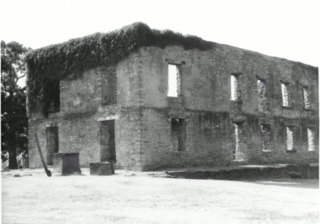
Fort Washita is the former United States military post and National Historic Landmark located in Durant, Oklahoma on SH 199. Established in 1842 by General Zachary Taylor to protect citizens of the Choctaw and Chickasaw Nations from the Plains Indians it was later abandoned by Federal forces at the beginning of the American Civil War. Confederate troops held the post until the end of the war when they burned the remaining structures. It was never reoccupied by the United States military. After years in private hands the Oklahoma Historical Society bought the fort grounds in 1962 and restored the site. Today, the Fort Washita Historic Site and Museum is a tourist attraction and hosts several events throughout the year, and it is jointly managed by the Chickasaw Nation and the Oklahoma Historical Society.
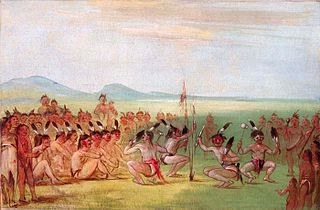
Red Shoes was a Choctaw chief who traded with British fur traders based in South Carolina in the 1740s and ignited the Choctaw Civil War. The French countered by arranging the assassination of Red Shoes. He was also known as Red Moccasin and was known in French as le Soulier Rouge.
The Cherokee people of the southeastern United States, and later Oklahoma and surrounding areas, have a long military history. Since European contact, Cherokee military activity has been documented in European records. Cherokee tribes and bands had a number of conflicts during the 18th century with Europeans, primarily British colonists from the Southern Colonies. The Eastern Band and Cherokees from the Indian Territory fought in the American Civil War, with bands allying with the Union or the Confederacy. Because many Cherokees allied with the Confederacy, the United States government required a new treaty with the nation after the war. Cherokees have also served in the United States military during the 20th and 21st centuries.
John Dabney Terrell Sr., surveyor, planter, and politician in Alabama, was born to a planter family in Bedford County, Virginia, and died in Marion County, Alabama. He moved to the region about 1814, well before Indian Removal beginning in the 1830s, and served as the United States Indian Agent to the Chickasaw under two presidents. He developed a plantation and was a slaveholder. He became active in territorial and state politics, serving as a state senator and also as a state representative.
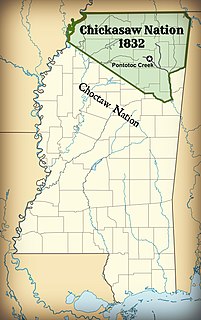
The Treaty of Pontotoc Creek was a treaty signed on October 20, 1832 by representatives of the United States and the Chiefs of the Chickasaw Nation assembled at the National Council House on Pontotoc Creek in Pontotoc, Mississippi. The treaty ceded the 6,283,804 million acres of the remaining Chickasaw homeland in Mississippi in return for Chickasaw relocation on an equal amount of land west of the Mississippi River.

Native American slave ownership refers to the ownership of enslaved Africans and Native Americans by Native Americans from the pre-colonial period to the U.S. Civil War. Waves of European colonization brought enslaved Africans to North America. Following this development many indigenous tribes began to acquire Africans as slaves. Many prominent people from the "Five Civilized Tribes" purchased slaves from their white neighbors and became members of the planter class. All slaves in the United States were emancipated upon ratification of the 13th Amendment, just after the American Civil War.
The Choctaw Civil War was a period of economic and social unrest among the Choctaw people that degenerated into a civil war between 1747 and 1750. The war was fought between two different factions within the Choctaw over what the tribes's trade relations with Great Britain and France should be. Hundreds of Choctaw peoples died in the war and the pro-French faction retained their influence within the Choctaw nation.

The history of slavery in Oklahoma began in the 1830s with the five Native American nations in the area: Cherokee, Chickasaw, Choctaw, Creek, and Seminole. Slavery within these Native American nations began simply by placing a lower status on them than their master. The slavery in these tribes varied in style, being specifically different from American slavery. Slavery in the area continued to grow for many years, even throughout the entirety of the Civil War. The growth was significant, slaves making up a portion of the population in the new Indian territory. Slavery ended in the Oklahoma area with the completion of the Civil War. Treaties were made with the nations regarding citizenship and slavery for African Americans. The repercussions of slavery that followed greatly affected the state, with prominent racial issues.